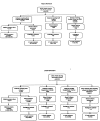Population-based incidence of typhoid fever in an urban informal settlement and a rural area in Kenya: implications for typhoid vaccine use in Africa
- PMID: 22276105
- PMCID: PMC3261857
- DOI: 10.1371/journal.pone.0029119
Population-based incidence of typhoid fever in an urban informal settlement and a rural area in Kenya: implications for typhoid vaccine use in Africa
Abstract
Background: High rates of typhoid fever in children in urban settings in Asia have led to focus on childhood immunization in Asian cities, but not in Africa, where data, mostly from rural areas, have shown low disease incidence. We set out to compare incidence of typhoid fever in a densely populated urban slum and a rural community in Kenya, hypothesizing higher rates in the urban area, given crowding and suboptimal access to safe water, sanitation and hygiene.
Methods: During 2007-9, we conducted population-based surveillance in Kibera, an urban informal settlement in Nairobi, and in Lwak, a rural area in western Kenya. Participants had free access to study clinics; field workers visited their homes biweekly to collect information about acute illnesses. In clinic, blood cultures were processed from patients with fever or pneumonia. Crude and adjusted incidence rates were calculated.
Results: In the urban site, the overall crude incidence of Salmonella enterica serovar Typhi (S. Typhi) bacteremia was 247 cases per 100,000 person-years of observation (pyo) with highest rates in children 5-9 years old (596 per 100,000 pyo) and 2-4 years old (521 per 100,000 pyo). Crude overall incidence in Lwak was 29 cases per 100,000 pyo with low rates in children 2-4 and 5-9 years old (28 and 18 cases per 100,000 pyo, respectively). Adjusted incidence rates were highest in 2-4 year old urban children (2,243 per 100,000 pyo) which were >15-fold higher than rates in the rural site for the same age group. Nearly 75% of S. Typhi isolates were multi-drug resistant.
Conclusions: This systematic urban slum and rural comparison showed dramatically higher typhoid incidence among urban children <10 years old with rates similar to those from Asian urban slums. The findings have potential policy implications for use of typhoid vaccines in increasingly urban Africa.
Conflict of interest statement
Figures



References
-
- Ernst R. Vol. 1994. p.23. Syracuse: Syracuse University Press; 1994. Immigrant life in New York City.
-
- Condran GA, Crimmins-Gardner E. Public health measures and mortality in US cities in the late nineteenth century. Human Ecology. 1978;6:27–54. - PubMed
-
- Cutler D, Miller G. The role of public health improvements in health advances: the twentieth century United States. Demographics. 2005;42:1–22. - PubMed
MeSH terms
Substances
LinkOut - more resources
Full Text Sources

